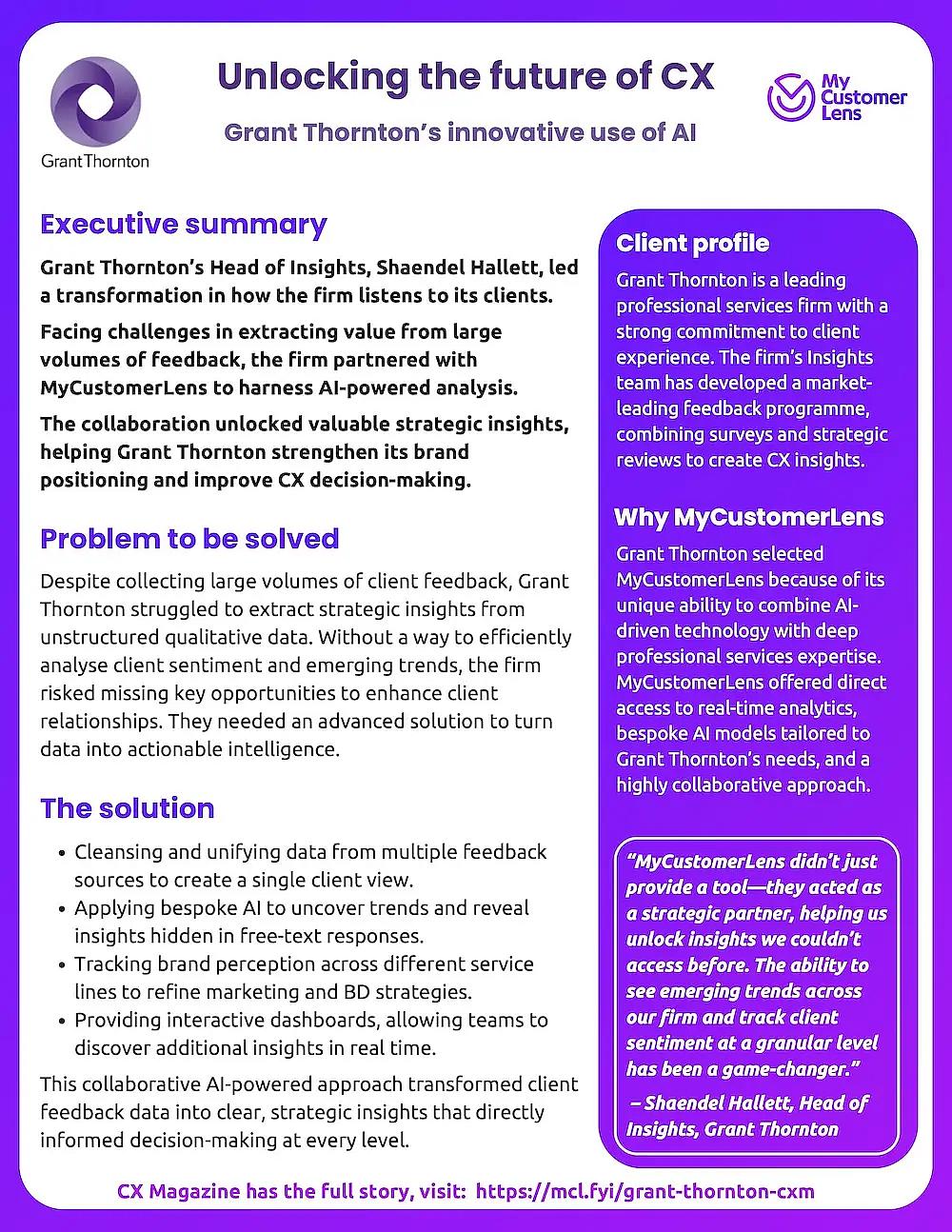Feedback Intelligence
Unlock deeper client insights and new growth opportunities with AI-driven analysis

The Challenge
Are you curious about what else your feedback data could be telling you? Or frustrated that your client listening isn’t revealing enough actionable insights? Are you missing the chance to drive organic growth?
You're not alone. Many professional services firms gather valuable feedback from surveys, interviews and reviews, but find it difficult to connect the dots and extract meaningful insights from their quantitative and qualitative data.
- Siloed data makes it impossible to see the big picture. Hidden trends and crucial client experience gaps go unnoticed.
- Manual analysis is time-consuming and inefficient. Teams waste valuable hours compiling and analysing data, leaving little time for strategic action.
- Decisions are based on existing assumptions, not new evidence. This can lead to client experiences becoming outdated.
The result - missed opportunities to strengthen client relationships, enhance service delivery and win work from new and existing clients.
The case for change
Without these actionable insights, firms are struggling to maximise the impact of their client listening. Some are still restricted to seasonal or annual listening projects.
If you can’t demonstrate the RoI of what you’re already doing, it’s hard to make the case for additional resources.
Feedback Intelligence projects are designed to fill this evidence gap for you.
How it Works:
- Unify: We bring your existing feedback data – surveys, interviews, reviews, emails, and more – into a single client view.
- Analyse: Our proprietary FeedbackAI automatically analyses unstructured text, identifying key themes, trends, and sentiment.
- Visualise: Interactive dashboards provide clear, concise visualisations of your data, enabling you to answer future questions about client perceptions.
- Act: Data-driven insights inform your strategy, enabling you to enhance client experience, strengthen relationships, and drive organic growth.

The Timeline: deep insights in just 6 weeks
We understand you need results quickly. Our streamlined process delivers actionable insights in just six weeks:
- Weeks 1-2: Data unification. You provide the data; we handle the cleansing and uploads.
- Weeks 3-4: AI-powered analysis. Our experts use bespoke AI processes to generate insights and interactive dashboards.
- Weeks 5-6: Insight reporting. We collaborate with you to refine the insights and deliver a summary report with clear recommendations. You also get 90 days access to the interactive dashboards for ongoing analysis.
Why Choose MyCustomerLens?
- Industry Expertise: We specialise in the professional services sector so we understand your unique challenges and needs.
- Collaborative Partnership: We work closely with you throughout the process, providing expert guidance and support.
- Custom AI: Our FeedbackAI is tailored to the nuances of professional services feedback, delivering more relevant and actionable insights.
- Proven Results: Feedback Intelligence has helped firms like Grant Thornton, Johnston Carmichael, and Wilkin Chapman achieve significant improvements in client experience and business performance.
Success story: How Grant Thornton used Feedback Intelligence to unlock new client insights
"MyCustomerLens didn’t just provide a tool—they acted as a strategic partner, helping us unlock insights we couldn’t access before. The ability to see emerging trends across our firm and track client sentiment at a granular level has been a game-changer."
Shaendel Hallett, Head of Client Insights
Shaendel Hallett, Head of Client Insights
Results: Improved strategic decision-making, enhanced CX programme, and stronger brand positioning.

Benefits to you
- Work with a partner that understands voice of client (VoC) data, AI analysis and how they can be combined to help you to achieve your personal goals and KPIs.
- Make your existing data work harder. Generate insights and actions that boost internal engagement with your listening programme.
- Demonstrate the impact of dedicated AI analysis. Build the case for investing in an AI-powered listing platform.
- Become more client-centric. Use the voice of your clients to inform client service decisions, business development and marketing.
Ready to Unlock Your Growth Potential?
Schedule a Free Consultation to discuss your specific needs and how Feedback Intelligence can help you achieve your goals.
Don't forget to join the Waiting List - we're currently onboarding one new client every two weeks. Secure your spot today.
Don't forget to join the Waiting List - we're currently onboarding one new client every two weeks. Secure your spot today.
